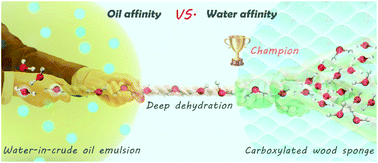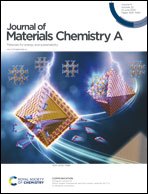Carboxylated wood-based sponges with underoil superhydrophilicity for deep dehydration of crude oil†
Abstract
Water cut crude oil needs to be deeply dehydrated before further transportation or refining because water residuals not only tremendously increase the transportation cost and energy consumption, but also harm the oil delivery pipelines and refining equipment. Herein, we report carboxylated wood-based sponges (CWS) with underoil super-hydrophilicity for removing water residuals from crude oil. These CWS are made of aligned cellulose nanofibers after the removal of lignin and hemicellulose from natural balsa wood. Removing lignin and hemicellulose breaks the thin cell walls of balsa wood, resulting in a lamellar structure in the freeze-dried CWS. This lamellar architecture endows the CWS with high mechanical compressibility and good elastic recovery. The CWS show fast and effective dehydration for crude oil with water residuals as low as 20 ppm. The absorbed crude oil can be easily recovered from the CWS by simple squeezing. Additionally, the CWS are not only reusable without performance decline during long-term operation, but also show good chemical stability even in strong acidic and basic environments. These results indicate that the CWS have great potential for deep dehydration of crude oil, especially for water-in-crude oil emulsions.



 Please wait while we load your content...
Please wait while we load your content...